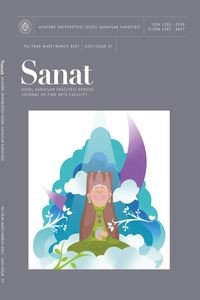Abstract
Sanat, ilkel dönemden günümüze kadarki zaman dilimi içinde toplumsal olaylardan da etkilenerek sürekli bir değişim içindedir. Sanatla birlikte, sanatın sergileme biçimleri de aynı doğrultuda değişmiştir.
Galeri mekânının geleneksel sergileme biçimleri, piyasayla kurduğu ilişki, dayatmacı estetik kuralları ve mükemmelliyetçi duvarları postmodernizm ile eleştirilen ve sanatçılar tarafından dönüştürülen bir mekân haline gelmiştir.
1960’larda sanat alanında yaşanan bu tepkisel kırılmaların sonucunda ortaya çıkan Arazi Sanatı bu anlayışın bir simgesi haline gelmiştir. Sanatçılar galeri mekânlarından uzaklaşarak atölyelerini doğaya taşıyarak geniş arazi parçalarını, zaman zaman da doğada bulunan malzemelerle galeri mekânını düzenlemişlerdir.
Bu süreçte doğa-sanat-mekân iç içe geçmiş, geçirdiği evrimleşme süreci ile beyaz küp yeni bir mecraya dönüşmüştür. Günümüzde gerçekleştirilen mekânın duvarlarını iten ve mekândan taşan ve doğa güçleri ile ortak çalışarak, meydan okuyan işler ile sanatçılar; sanatın neliği, bir sanat sergisinin ne olabileceği ve bir sanat kurumunun ne kadar ileri gitmeye hazır olduğu gibi sorulara dair sınırları zorlayan cevaplar aramışlardır.
Bu çalışmada; sanat, tarihsel süreçte galeri mekânının değişimi ve sanat kurumları ile sanatçı ilişkisi irdelenmiş, geleneksel galeri algısıyla bir hesaplaşmaya giren sanatçıların süreç içerisindeki sınırları zorlayan eylemleri güncel işler üzerinden örneklenmiştir.
Keywords
References
- Referans 1 Antmen, A. (2008). 20. Yüzyıl Batı Sanatında Akımlar. İstanbul: Sel Yayıncılık
- Referans 2 Atakan, N. (2015). Sanatta Alternatif Arayışlar. İzmir: Karakalem Kitabevi Yayınları.
- Referans 3 Brown, A. (2014). Güncel Sanat ve Ekoloji. (Çev. Emre GÖRGÜ, Yiğit ADAM). İstanbul: Lal Yayınları.
- Referans 4 Fineberg, J. (2014). 1940’tan Günümüze Sanat. (Çev. Simber ATAY ESKİER, Göral Erinç YILMAZ). İzmir: Karakalem Kitabevi Yayınları.
- Referans 5 Germaner, S. (1997). 1960 Sonrası Sanat. Akımlar, Eğilimler, Gruplar, Sanatçılar. İstanbul: Kabalcı Yayınevi
- Referans 6 Gintz, C. (2010). Başka Yerde & Başka Biçimde. (Çev. Muna Cedden).Ankara: Dost Kitabevi Yayınları
- Referans 7 Karavit, C. (2008). Yeryüzü Sanatı. İstanbul: Telos Yayıncılık
- Referans 8 Kastner, J., Wallis B. (1998). Land and Environmental Art Paperback Phaldon Press.
- Referans 9 Lynton, N. (2015). Modern Sanatın Öyküsü. İstanbul: Remzi Kitabevi.
- Referans 10 O’Doherty, B. (2010). Beyaz Küpün İçinde. Galeri Mekanının İdeolojisi. (Çev. Ahu Antmen). İstanbul: Sel Yayıncılık
- Referans 11 Yılmaz, M. (2006). Modernizmden Postmodernizme Sanat. Ankara: Ütopya Yayınevi
- Referans 12 Yücel, D. (2012). Yeni Medya Sanatı ve Yeni Müze. İstanbul Kültür Üniversitesi, İstanbul: Yazın Basın Yayın Matbaacılık.
Abstract
Art, from the primitive period to the present, is in a constant change, also affected by social events. Along with the art, the exhibition forms of art have also changed in the same direction.
The traditional exhibition forms of the gallery space, its relationship with the market, its imposing aesthetic rules and perfectionist walls have become a space that has been criticized by posmodernism and transformed by artists. Land Art, which emerged as a result of these reactive breaks in the field of art in the 1960s, has become a symbol of this understanding. The artists moved away from the gallery spaces and moved their workshops to the nature, organizing the vast pieces of land, and sometimes the gallery space with materials found in nature.
In this process, nature-art-space intertwined, and the white cube turned into a new medium with its evolutionary process. Artists who push the walls of the space realized today and overflow from the place and work in partnership with the forces of nature, with their challenging works; They sought boundary-pushing answers to questions such as what art is, what an art exhibition could be, and how far an art institution is ready to go. In this study; Art, the change of the gallery space in the historical process and the relationship between art institutions and the artist are examined, and the actions of the artists who have come to terms with the traditional gallery perception pushing the boundaries in the process are exemplified through current works.
References
- Referans 1 Antmen, A. (2008). 20. Yüzyıl Batı Sanatında Akımlar. İstanbul: Sel Yayıncılık
- Referans 2 Atakan, N. (2015). Sanatta Alternatif Arayışlar. İzmir: Karakalem Kitabevi Yayınları.
- Referans 3 Brown, A. (2014). Güncel Sanat ve Ekoloji. (Çev. Emre GÖRGÜ, Yiğit ADAM). İstanbul: Lal Yayınları.
- Referans 4 Fineberg, J. (2014). 1940’tan Günümüze Sanat. (Çev. Simber ATAY ESKİER, Göral Erinç YILMAZ). İzmir: Karakalem Kitabevi Yayınları.
- Referans 5 Germaner, S. (1997). 1960 Sonrası Sanat. Akımlar, Eğilimler, Gruplar, Sanatçılar. İstanbul: Kabalcı Yayınevi
- Referans 6 Gintz, C. (2010). Başka Yerde & Başka Biçimde. (Çev. Muna Cedden).Ankara: Dost Kitabevi Yayınları
- Referans 7 Karavit, C. (2008). Yeryüzü Sanatı. İstanbul: Telos Yayıncılık
- Referans 8 Kastner, J., Wallis B. (1998). Land and Environmental Art Paperback Phaldon Press.
- Referans 9 Lynton, N. (2015). Modern Sanatın Öyküsü. İstanbul: Remzi Kitabevi.
- Referans 10 O’Doherty, B. (2010). Beyaz Küpün İçinde. Galeri Mekanının İdeolojisi. (Çev. Ahu Antmen). İstanbul: Sel Yayıncılık
- Referans 11 Yılmaz, M. (2006). Modernizmden Postmodernizme Sanat. Ankara: Ütopya Yayınevi
- Referans 12 Yücel, D. (2012). Yeni Medya Sanatı ve Yeni Müze. İstanbul Kültür Üniversitesi, İstanbul: Yazın Basın Yayın Matbaacılık.
Details
| Primary Language | Turkish |
|---|---|
| Journal Section | Makaleler |
| Authors | |
| Publication Date | March 29, 2021 |
| Submission Date | February 1, 2021 |
| Published in Issue | Year 2021 Issue: 37 |

Bu eser Creative Commons Atıf-GayriTicari 4.0 Uluslararası Lisansı ile lisanslanmıştır.


